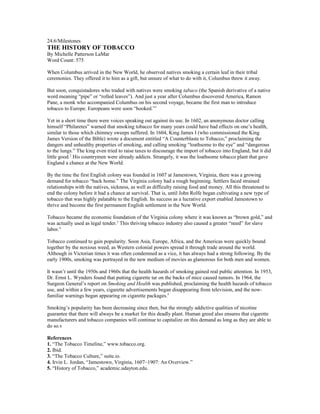
8. The History of Tobacco copyedit2
- 1. 24.6/Milestones THE HISTORY OF TOBACCO By Michelle Patterson LaMar Word Count: 575 When Columbus arrived in the New World, he observed natives smoking a certain leaf in their tribal ceremonies. They offered it to him as a gift, but unsure of what to do with it, Columbus threw it away. But soon, conquistadores who traded with natives were smoking tabaco (the Spanish derivative of a native word meaning “pipe” or “rolled leaves”). And just a year after Columbus discovered America, Ramon Pane, a monk who accompanied Columbus on his second voyage, became the first man to introduce tobacco to Europe. Europeans were soon “hooked.”1 Yet in a short time there were voices speaking out against its use. In 1602, an anonymous doctor calling himself “Philaretes” warned that smoking tobacco for many years could have bad effects on one’s health, similar to those which chimney sweeps suffered. In 1604, King James I (who commissioned the King James Version of the Bible) wrote a document entitled “A Counterblaste to Tobacco,” proclaiming the dangers and unhealthy properties of smoking, and calling smoking “loathsome to the eye” and “dangerous to the lungs.” The king even tried to raise taxes to discourage the import of tobacco into England, but it did little good.2 His countrymen were already addicts. Strangely, it was the loathsome tobacco plant that gave England a chance at the New World. By the time the first English colony was founded in 1607 at Jamestown, Virginia, there was a growing demand for tobacco “back home.” The Virginia colony had a rough beginning. Settlers faced strained relationships with the natives, sickness, as well as difficulty raising food and money. All this threatened to end the colony before it had a chance at survival. That is, until John Rolfe began cultivating a new type of tobacco that was highly palatable to the English. Its success as a lucrative export enabled Jamestown to thrive and become the first permanent English settlement in the New World. Tobacco became the economic foundation of the Virginia colony where it was known as “brown gold,” and was actually used as legal tender.3 This thriving tobacco industry also caused a greater “need” for slave labor.4 Tobacco continued to gain popularity. Soon Asia, Europe, Africa, and the Americas were quickly bound together by the noxious weed, as Western colonial powers spread it through trade around the world. Although in Victorian times it was often condemned as a vice, it has always had a strong following. By the early 1900s, smoking was portrayed in the new medium of movies as glamorous for both men and women. It wasn’t until the 1950s and 1960s that the health hazards of smoking gained real public attention. In 1953, Dr. Ernst L. Wynders found that putting cigarette tar on the backs of mice caused tumors. In 1964, the Surgeon General’s report on Smoking and Health was published, proclaiming the health hazards of tobacco use, and within a few years, cigarette advertisements began disappearing from television, and the now- familiar warnings began appearing on cigarette packages.5 Smoking’s popularity has been decreasing since then, but the strongly addictive qualities of nicotine guarantee that there will always be a market for this deadly plant. Human greed also ensures that cigarette manufacturers and tobacco companies will continue to capitalize on this demand as long as they are able to do so.v References 1. “The Tobacco Timeline,” www.tobacco.org. 2. Ibid. 3. “The Tobacco Culture,” suite.io. 4. Irvin L. Jordan, “Jamestown, Virginia, 1607–1907: An Overview.” 5. “History of Tobacco,” academic.udayton.edu.
- 2. Michelle Patterson LaMar is the production manager for Last Generation magazine.